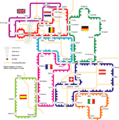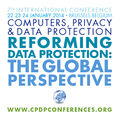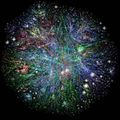User:Jules/imagininginfrastructures
I have recently read very carefully the 4th Chapter of Martin Dodge's phd thesis: "Understanding Cyberspace Cartographies: A Critical Analysis of Internet Infrastructure Mapping"
The chapter itself is called "Imagining Internet Infrastructures : Metaphors and scientific inscription".
The following wrap up has been enabled after a thourough session of reprocessing some information extracted from the text with the help of Manetta <3.
Last year, Manetta and I had started looking at metaphors of the Internet. We had at the time established the three following categories for classifying metaphors :
- raw material & transformation (data like material resource)
- local & global (land, territory to explore)
- motion & experience (navigating, displacement)
This reading was initially aimed for me to go forward with the context of our project, but ended up clearing things up for my work as well.
In fact, I feel like it helped me understand why I feel unsettled with everything I do. The chapter covers really nicely and comprehensively the ways we make an invisible infrastructure tangible to ourselves and why they're all questionable.
–---
About invisibility, the core issue
There are several dimensions to which the invisibility of Internet infrastructures applies.
Firstly there is a material dimension. The physical infrastructure is hidden from sight. Fibre optic cables lay underground or at the bottom of the seas, wiring cabinets are discrete and anonymous part of street furniture, data centres are moved far from populated places. Moreover the Internet becomes more ubiquitous by getting propagated wirelessly. On a phenomenological aspect, data doesn't manifest itself through human senses, data is made of discrete states of energy without weight, smell, sound or colour, etc... Secondly, it is invisible in use. There is no possible physical interaction enabling the user to “feel” the pace at which data travels. This is a characteristic inherent to telecommunication, there is a lack of human touch. As a consequence, the user cannot gain knowledge of the Infrastructure through navigation. Interfaces also hide all procedures at the back, that type of information is concealed. There is also an aim to fade the Internet within all daily activities, making it even more seamless. The fact that the Internet is taken for granted constitutes another dimension. People don't feel a need to define what it is anymore, it has vanished from their consciousness to become a “commonplace”.
“As infrastructures become more transparent (and more reliable, affordable and universally available), so they morph in character from desired conveniences to a necessary and seemingly naturally-given part of the lived environment.”
Lastly discussed, the operating force behind the Internet is also quite hidden. The institutional practice is embedded within different activities like construction, maintenance, business, finance, standards... These are bound within politico-economical structures and it is quite hard to grasp where decisions are made since there seem to be quite a fragmentation. This infrastructural invisibility makes it complicated to grasp the socio political implications of the Internet and doesn't enable much analysis and critic of its impact on society and of the way it is operated. Invisibility prevents from any possibility to discuss alternative ways of operating the infrastructure. Metaphors and scientific inscription are used to make the Internet visible to the masses and produce facts about its “nature”.
On metaphors
Metaphors help familiarising with the unknown. They create meaning and unveil certain aspects of the Internet, although they cannot apply to it as a whole, since there are so many dimensions to it. They are performative cognitive assets, also influencing the direction that the technology will lean towards. Their creation always support particular stories that their initiator wants to communicate. They generate a possible understanding by focusing on one aspect while hiding others.
--- Here I am only listing the categories discussed by the author
1. Linguistic and spatial (cognitive) metaphors
The use of metaphors is a form of classification and conceptualisation, relating the object to a set of well known categories. Which is a form of figurative speech, fundamental to human language and which structure cognitive experience (Lakoff and Johnson, 1980)
Metaphors “create a 'stereoscopic' vision which allows for simultaneous viewing of an idea from two or more points of view" (Sawhney, 1996).
Metaphors entering the linguistic/spatial category tend to focus on different levels of the apprehension of space:
A. Linguistic spatial metaphors
It started in the 90s, because the Internet was very new and had to be adopted by the masses.
They came from very different frameworks:
- living organism → tree, body, brain
- city, urban space → streets, halls, suburbs
- marketplace → online shops, e-trading, virtual money
- written text → letter/email, addresses, signature files
B. Frontier related
→ mapping frontiers renders uncertain spaces as definite lines (cf Torsedillaline dividing the new world for Spain and Portugal)
→ mapping frontiers unveils their existence and representation fixes their position
→ all world maps are semiotically frontier signs
→ on the ground, the frontier line is not physically traceable yet maps construct territory
→ it is even more connoted when there is an idea of overcoming the tyranny of place and time
Metaphors draw a line.
C. Familiar architectural places / container-like space
Libraries, shops, farms / room, sites, cities, communities, sphere, worlds, cyberspace
Architectural space metaphors are very common
→ home and work gave concrete forms to internet infrastructures and intangible media
(homepage, digital libraries, virtual classrooms, server farms)
D. Transport and motion
surfing, exploring, homesteading
→ Navigation of the static individual
Pipes, routes, rails, roads
→ analogies with data flow
2. Visual metaphors for Internet infrastructure
Visual metaphors encompass:
A. Wiring visions
topological generalisation morphs the Internet as:
- conventional geographical network
- variable scale distortion subway maps
- non / alternative geographical circuits diagrams
B. Global visions
Heroic / God-like point of view, over the Earth wrapped into telecommunication.
→ integral to the imagery of corporate capitalism and environmental movements (telecommunications, aviation, Whole Earth idea, www, global village)
→ iconic symbol of world wide business and institutions
→ also derived from cold war arm-race, satellite monitoring, military control and command
C. machine-like visions
Physical machine modelling the Internet's concept
The Internet as machine with working parts that can handle and transport items of data.
Useful for educational purposes. Usually a “tin cans and strings” diagram.
example : warriors of the net - https://www.youtube.com/watch?v=PBWhzz_Gn10
D. Abstract visions
Naturalistic iconography of organic structures (tree branches with leaves, fractals, spiderwebs, brains and veins)
Aesthetics of meteorology and astronomy (clouds, nebulas, star clusters)
These graphs show nothing despite their claims, they are “artistic images” for “science museums”.
There is most of the time no instruction on how to interpret them, they connote the “sublime” of the Infrastructure and demonstrate the technical power if their creators.
About scientific inscription
Sciences do not discover 'laws of nature'. They rather construct knowledge by stabilising experimental findings as 'facts'. The phenomenas to be experimented are usually undetectable directly by human senses, they have to be made visually apparent. Hence why sciences create modes of inscription to enable the production of facts. According to Bruno Latour, laboratory work is a cascade of inscriptions.
The last part about scientific inscription is very crucial to me, since their hidden subjectivity seems at the core of my insatisfaction with the methods I deploy to objectify the Internet as a tangible fact. Objectifying the Internet as a state of fact is an impossible task, since it involves the creation of a strategy, or apparatus, for the exposure of certain aspects which are considered worth communicating about.
Sawhney (1996): “The initial metaphors basically function as provisional hypotheses which can be held only as long as the facts permit”
Also, I feel that the wider familiarisation of the public with tools for data inscription coincides with a decreasing interest in the use and production of metaphors to understand the Internet. From circa 2010, there has been a big hype around tools such as processing for designers [1]. Inscription tools have enabled the production of visual representations where “the network manifests itself” as if automation and data fetching could enable designers to get a more accurate picture.
More widely, the myth of objectivity is in itself a subjective construction redefining itself throughout time. The scientific Enlightenment revolution is coined with the popularisation of the linear perspective during the Renaissance. It is a method for the inscription of space, as perceived by the human eye, according to a shared set of rules. Calibrating construction lines to position elements onto a sheet of paper involves the use of a system to allocate proportions. Those systems have varied throughout time. Nowadays most people would rely on the metric system for establishing measures and drawing shapes with geometrical proportions. The metric system was established as a consequence of the First French republic and started to be internationally adopted by the territories conquered during the Napoleonic wars. The French quest for domination at the time is certainly part of the political history of the wide adoption of this system.
Scientific inscription methods are agreed upon by establishing a system that would capture natural phenomenas, aiming to remove individual subjectivity in the process of doing so. Scientists, viewers, initiators would only stand as witnesses.
History shows that the conceptions over objectivity have evolved a lot through time. For Plato, mimesis was the enemy of truth, mimesis being the depicting of reality in a deceptive way. Plato didn't appreciate Art, and maintained that artists should be banished from society. Under the reign of Charles Lebrun at the French Academy of the Arts in the 17th, the Poussinists argued for geometrical rigour and the use of reason in composition. They regarded themselves as some inheritors of the platonic idea while the Rubenists would be associated with mimesis, holding colour as the main talent of the painter, as it would reach a wider audience through sensorial stimulation. Now, it is very possible that Plato would have stood against the Poussinists. Their technical apprehension of the depiction of reality came after Leon Battista's prescriptions. The notion of objectivity was still there but it manifested under different semantic codifications.
"the function of colour is to satisfy the eyes, whereas drawing satisfies the mind."
Charles Lebrun
Somehow, the Western debate has always opposed the intellect and sensorial, instead of trying to articulate the relation holding them together. Nowadays, interface design paradigms also display these mind versus senses, as if common sense and perception couldn't be associated. While the technical paradigm wants to expose the software's mechanisms, the metaphor paradigm hides the softwares operations behind interfaces displaying signs already familiar to the user to facilitate the interaction. [2]
Objectivity is achieved through the use of particular methods and visual language commonly agreed upon. By using such means, scientists aim to remove all traces of human subjectivity in revealing what's not perceptible to the human eye as pure facts. Yet the establishment of such systems results from the influence of varied parameters such as politics, beliefs, economy... More importantly, it is nested within a genealogy of inscription devices, since it needs to build upon previous methods to hold the sensation of progress.
- ↑ see the amount of publications related to the topic https://processing.org/books/
- ↑ https://tafein2009.files.wordpress.com/2009/09/the-myth-of-metaphor.pdf









